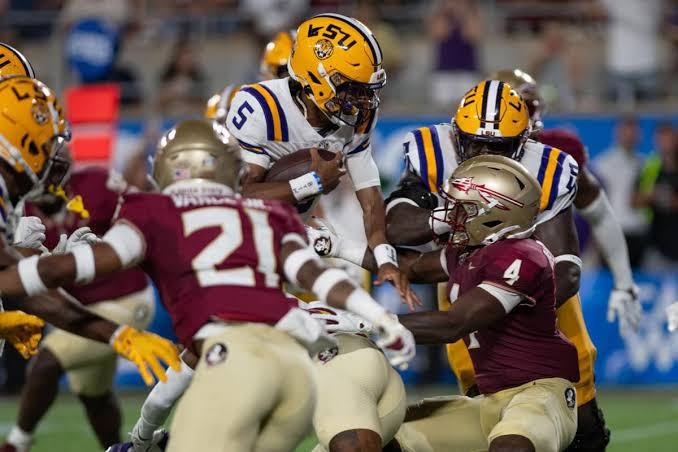LSU Football: Three Key Takeaways from LSU's Loss to Florida State
In a disappointing display on Sunday night, the LSU Tigers stumbled in the second half, and it was their struggles in the secondary that stole the spotlight.
LSU's defense crumbled like a fragile house of cards during the second half showdown against the formidable No. 8 Florida State in Camping World Stadium. The Jordan Travis-Keon Coleman connection proved to be too much for the Tigers' secondary.
Brian Kelly's coaching squad found themselves outscored 31-7 in the second half, as the Seminoles embarked on an impressive 31-0 run in the final two quarters, securing a decisive 45-24 victory over the Tigers.
So, what stood out on that fateful Sunday night? Let's dive into the three critical observations from LSU's Week 1 loss to Florida State:
1. Utter Collapse of the Secondary:
Florida State dominated the aerial game, with quarterback Jordan Travis amassing 342 yards on 23-of-42 passing, contributing four total touchdowns. LSU's secondary had no answer for this Heisman candidate, as Travis consistently exploited their vulnerabilities.
Louisiana native and Florida State's star wide receiver, Keon Coleman, delivered a dazzling performance in his Seminole debut. The Michigan State transfer lived up to the tremendous hype surrounding him. At halftime, Coleman had already secured 4 catches for 62 yards and 2 touchdowns, but his second-half performance was nothing short of electrifying.
As the second half unfolded, Coleman continued to outshine LSU cornerback Duce Chestnut, particularly in the red zone, scoring his third touchdown of the night. Coleman's final stat line read nine receptions for 122 yards and three touchdowns. The second half witnessed an absolute collapse of LSU's secondary, and Coleman seized every opportunity.
The cornerback duo of Zy Alexander and Duce Chestnut, along with Greg Brooks, Andre Sam, and Major Burns, rounded out LSU's secondary. However, it was a challenging night for Chestnut, as his matchup with Coleman took center stage, with Coleman consistently winning the battle.
2. The Mystery of Harold Perkins' Role:
LSU linebacker Harold Perkins, known for his exceptional pass-rushing abilities, found himself covering the field for a career-high 28 snaps while only rushing the passer seven times against Florida State. This decision, orchestrated by defensive coordinator Matt House and his staff, left many scratching their heads, as they limited one of college football's top pass rushers to a singular role.
Perkins had showcased his pass-rushing prowess during his freshman year but transitioned to an inside linebacker role during the offseason. It was evident that this shift would define his new role. However, the decision to predominantly deploy Perkins in a coverage role raised eyebrows, as one of America's most dynamic pass rushers couldn't contain FSU quarterback Jordan Travis effectively.
3. Lack of a Consistent Rushing Attack:
LSU opted for Kevontre Bradford as the starting running back against Florida State, a decision that initially showed promise but quickly faded as the game progressed. Although Noah Cain and Josh Williams joined the mix after the first few drives, the Tigers' running game vanished.
Bradford ignited hope with a 55-yard wheel route on the first play of the game, but the subsequent underutilization of the running back corps left fans puzzled. Florida State's formidable defensive line played a significant role in stifling LSU's rushing attack, and once again, the Tigers heavily relied on quarterback Jayden Daniels.
While LSU's ground game posted 113 yards on the day, it's worth noting that two significant breakaway runs by Daniels and Josh Williams inflated these numbers substantially. LSU struggled to establish a consistent rushing rhythm, reminiscent of their struggles from the previous season.
Notre Dame transfer Logan Diggs remained sidelined due to a "coach's decision," as confirmed by Brian Kelly, with LSU primarily relying on Bradford, Cain, and Williams as the primary backs. Looking ahead, it's imperative for the program to tap into its deep running back pool to achieve a balanced offensive approach, especially as SEC play looms on the horizon.






